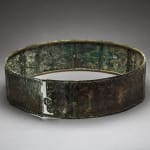Urartian Bronze Belt, 740 BCE - 640 BCE
Sheet Metal
34.5 x 8.9 cm
13 5/8 x 3 1/2 in
13 5/8 x 3 1/2 in
LO.631
Further images
The kingdom of Urartu, originally a confederation of numerous tribes from Eastern Anatolia, was one of the most powerful states in the Ancient Near East during the first half of...
The kingdom of Urartu, originally a confederation of numerous tribes from Eastern Anatolia, was one of the most powerful states in the Ancient Near East during the first half of the first millennium BC, constituting one of the fiercest rivals of the Assyrian Empire. It was in the 9th century BC under Shalmaneser III (858-824) that the Urartian state developed a centralised system with several interconnected palace-fortresses placed on high rock outcrops, protected from their rivals, the Assyrians.
Yet our knowledge of Urartian culture and history is mostly based on epigraphic evidence found especially in the area of Lake Van and in the Assyrian chronicles. From these sources, we know that during the 8th century BC Urartu expanded from Northern Turkey and Armenia, into Azerbaijan, Kurdistan and the Euphrates region, eventually coming into friction with the Assyrians and the Persians. Most of their military campaigns were indeed aimed at acquiring silver, copper and iron ores for their intensive metal-smithing industry.
When observing the military paraphernalia, such as helmets, quivers, and belts, the decoration undoubtedly can highlight important clues on the life and beliefs of the Urartian people during the two hundred and fifty years of existence of their kingdom,especially considering the paucity of alternative sources of archaeological evidence.
Although quite extensively produced, belts were in fact manufactured only for a period of one and a half centuries. This particular belt, made of sheet metal, hammered, chased and perforated along the borders to attach a leather lining, can be ascribed to a specific subgroup dated to the late 8th - early 7th centuries BC. Worked from both sides by punching, on its outer surface, the belt bears a hunting scene in relief with a single hunter on horseback amidst galloping horses, lions and bulls in flight, all rendered with a great sense of movement, a feature absent in earlier examples. In addition, floral and geometrical ornaments have been arbitrarily inserted as spacers in a manner common only from the mid eight century; here the once large carefully worked rosette (originally a sun symbol as illustrated on the wall paintings at Altin tepe) has become pure ornament, as has the winged disk.
This beautiful ceremonial belt, which would have originally been fastened with a leather strip tied to the small loop at the front, in terms of décor and technique represents one of the finest and most informative, yet un-deciphered remains of the material culture of the Urartian kingdom during its political apogee.
Yet our knowledge of Urartian culture and history is mostly based on epigraphic evidence found especially in the area of Lake Van and in the Assyrian chronicles. From these sources, we know that during the 8th century BC Urartu expanded from Northern Turkey and Armenia, into Azerbaijan, Kurdistan and the Euphrates region, eventually coming into friction with the Assyrians and the Persians. Most of their military campaigns were indeed aimed at acquiring silver, copper and iron ores for their intensive metal-smithing industry.
When observing the military paraphernalia, such as helmets, quivers, and belts, the decoration undoubtedly can highlight important clues on the life and beliefs of the Urartian people during the two hundred and fifty years of existence of their kingdom,especially considering the paucity of alternative sources of archaeological evidence.
Although quite extensively produced, belts were in fact manufactured only for a period of one and a half centuries. This particular belt, made of sheet metal, hammered, chased and perforated along the borders to attach a leather lining, can be ascribed to a specific subgroup dated to the late 8th - early 7th centuries BC. Worked from both sides by punching, on its outer surface, the belt bears a hunting scene in relief with a single hunter on horseback amidst galloping horses, lions and bulls in flight, all rendered with a great sense of movement, a feature absent in earlier examples. In addition, floral and geometrical ornaments have been arbitrarily inserted as spacers in a manner common only from the mid eight century; here the once large carefully worked rosette (originally a sun symbol as illustrated on the wall paintings at Altin tepe) has become pure ornament, as has the winged disk.
This beautiful ceremonial belt, which would have originally been fastened with a leather strip tied to the small loop at the front, in terms of décor and technique represents one of the finest and most informative, yet un-deciphered remains of the material culture of the Urartian kingdom during its political apogee.







